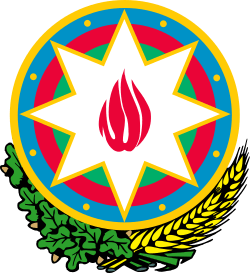Azerbaijani Community of Nagorno-Karabakh
The Azerbaijani Community of Nagorno-Karabakh (Azerbaijani: Dağlıq Qarabağın Azərbaycanlı İcması), also known as the Azerbaijani Community of Nagorno-Karabakh Social Union and the Azerbaijani Community of Nagorno-Karabakh in exile, is a social union representing the Azerbaijani community of Nagorno (Upper) Karabakh, in exile since May 1994.
| Dağlıq Qarabağın Azərbaycanlı İcması | |
 Coat of Arms of Azerbaijan | |
| Agency overview | |
|---|---|
| Formed | March 24, 1992 |
| Headquarters | Baku, Azerbaijan Republic |
| Agency executive |
|
| Website | http://www.karabakh.az |
History
According to the 1979 Soviet census, which was the last census taken before the beginning of the Nagorno-Karabakh conflict, there were 37,264 ethnic Azeris (or 23% of the total population) living in the mainly Armenian-populated Nagorno-Karabakh Autonomous Oblast. Azeris constituted majority in the Shusha District with over 80% of the total population, in addition to forming between 15% and 26% of the population of the remaining four districts. The population of the regional capital of Stepanakert consisted of 11% ethnic Azeris.[1] Major Azeri settlements outside of the Shusha District included Sırxavənd, İmarət Qərvənd, Umudlu, and Çərəktar in the Mardakert District; Xocalı, Kərkicahan, Malıbəyli, Yuxarı Quşçular, Aşağı Quşçular, Cəmilli, and Meşəli in the Askeran District; Tuğ and Salaketin in the Hadrut District; and Qaradağlı, Muğanlı, Əmiranlar, and Divanlılar in the Martuni District.[2]
As result of attacks and military operations in the active phase of the conflict starting in 1991, almost all Azeris were forced to abandon their homes. There have been recorded cases of violence against Azeri civilians by Armenian militants (in Meşəli), civil casualties as a result of shelling (in Malıbəyli and Aşağı Quşçular) and burning down of entire villages (İmarət Qərvənd).[3]
Nizami Bahmanov, who had been appointed the Head of Executive Power of Shusha on April 8, 1992, became the first elected leader of the Azeri community.[4] Since Shusha was the only city in Nagorno-Karabakh with a majority Azerbaijani population, its executive officer was chosen to represent the whole Azerbaijani community of Karabakh. When a provisional ceasefire agreement was signed by Azerbaijan, Armenia and a representative of the Armenians of Nagorno-Karabakh, Bahmanov was expected to add his signature to the document as well, but was away on that day.[5] Nevertheless, along with their visits to Stepanakert, mediators of the OSCE Minsk Group hold regular meetings with the Azeri community as part of the peace process.[6][7][8]
The status of the Azerbaijani Community of Nagorno-Karabakh Social Union, co-founded by Nizami Bahmanov, member of Azerbaijani Parliament, Havva Mammadova and Elman Mammadov, was formally confirmed by the Ministry of Justice of Azerbaijan in September 2006.[9][10]
Bahmanov died on September 13, 2008 while holding a meeting in his office.[11] The office of the leader of Azerbaijani Community of Nagorno-Karabakh remained unoccupied until February 27, 2009 when Bayram Safarov was appointed the Head of Executive Power of Shusha, subsequently filling the office of leader of Azerbaijani Community of Nagorno-Karabakh.[9][12] The name of the organization was changed to Azerbaijani Community of Nagorno-Karabakh Public Union on June 5, 2010.[9][10] In 2018, diplomat Tural Ganjaliyev, a native of Shusha, replaced Safarov as the head of the community.[13]
Structure
The union is a non-governmental organization, gaining no financial profit and based on volunteer membership. Its activities cover the whole territory of Azerbaijan. The union's main purpose is the restoration of the territorial integrity of Azerbaijan and the return of Azerbaijani IDPs from Karabakh to their homes.
See also
References
- Population of Nagorno-Karabakh.
- Артур Цуциев. Атлас этнополитической истории Кавказа (1774-2004). Карта 33.
- Доклад правозащитного центра «Мемориал» о массовых нарушениях прав человека, связанных с занятием населенного пункта Ходжалы в ночь с 25 на 26 февраля 1992 г. вооруженными формированиями Archived 2019-07-09 at the Wayback Machine.
- "Nizami Bəhmənov iş otağında vəfat edib" [Nizami Bahmanov died in office]. Ria Information Agency. Archived from the original on 2012-03-10. Retrieved 2010-11-26.
- БИШКЕКСКИЙ ПРОТОКОЛ
- Сопредседатели МГ ОБСЕ встретились с представителями азербайджанской общины Карабаха.
- Сопредседатель МГ ОБСЕ: Без решения вопроса с беженцами невозможно достичь всестороннего урегулирования конфликта.
- Представители азербайджанской общины Нагорно-Карабахского региона АР об условиях установления мира в регионе.
- Javid Turan. "DAĞLIQ QARABAĞIN AZƏRBAYCANLI İCMASI YENİDƏN TƏŞKİLATLANIR" [Azerbaijani Community of Nagorno-Karabakh is being regrouped]. Yeni Musavat. Archived from the original on 2011-10-07. Retrieved 2010-11-26.
- ""DAĞLIQ QARABAĞ BÖLGƏSİNİN AZƏRBAYCANLI İCMASI" İCTİMAİ BİRLİYİNİN NİZAMNAMƏSİ" [Charter of the Azerbaijani Community of Nagorno-Karabakh region]. Media Forum. 2009-06-08. Archived from the original on 2011-07-17. Retrieved 2010-11-26.
- Mahbube Gasimbeyli (2008-09-13). ""Dağlıq Qarabağın Azərbaycanlı İcması"nın rəhbəri Nizami Bəhmənov vəfat edib" [The leader of the Azerbaijani Community of Nagorno-Karabakh region passed away]. Azeri Press Agency. Archived from the original on 2011-08-12. Retrieved 2010-11-26.
- Ilgar Rasul (2009-06-05). "Dağlıq Qarabağın Azərbaycanlı İcması özünə yeni rəhbər seçdi" [The Azerbaijani Community of Nagorno-Karabakh elected its leader]. RFE/RL. Retrieved 2010-11-26.
- Azerbaijani Nagorno-Karabakh community receives new head – what does this mean for conflict negotiations?. 21 December 2018.